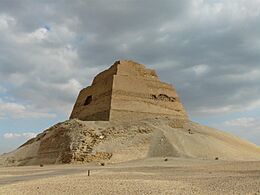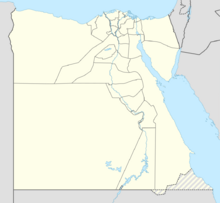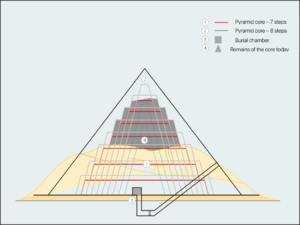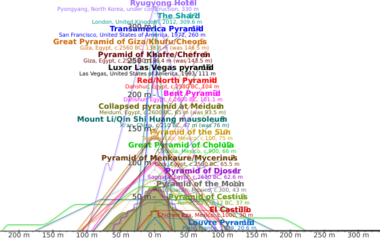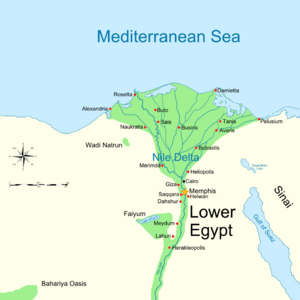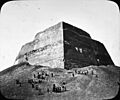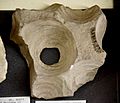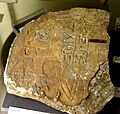Meidum facts for kids
Quick facts for kids Meidum Pyramid |
|
|---|---|
|
View of the Meidum Pyramid
|
|
| Coordinates | 29°23′17″N 31°09′25″E / 29.38806°N 31.15694°E |
| Type | Step pyramid |
| Height | 65 metres (213 ft) (ruined); would have been 91.65 metres (301 ft) or 175 cubits |
| Base | 144 metres (472 ft) or 275 cubits |
| Slope | 51°50'35" |
Meidum (also spelled Maydum or Maidum) is an important archaeological site in Lower Egypt. It's famous for its large pyramid and several ancient tombs made of mudbrick. This pyramid was the first in Egypt to have straight sides, but parts of it collapsed a very long time ago. The site is located about 72 kilometers (45 miles) south of the modern city of Cairo.
Contents
The Meidum Pyramid: Egypt's First Straight-Sided Pyramid
The pyramid at Meidum is believed to be only the second pyramid ever built in Egypt, after the Pyramid of Djoser. It might have been started by Huni, the last pharaoh of the Third Dynasty, and then finished by Sneferu. Because of its unusual look, Egyptians today sometimes call it el-heram el-kaddaab, which means "False Pyramid."
How the Meidum Pyramid Was Built
This pyramid was built in three main stages, which archaeologists call E1, E2, and E3.
- E1: The first stage was a step pyramid, similar to the Djoser Pyramid. It had five steps.
- E2: Builders then added an extension around the first pyramid, making it about 5 meters (16 feet) wider. This increased the number of steps from 5 to 7.
- E3: In the final stage, the builders tried to turn the step pyramid into a true pyramid with smooth, straight sides. They did this by filling in the steps with limestone blocks.
Why the Meidum Pyramid Collapsed
Even though the idea of filling in the steps was used for other true pyramids, there were some big mistakes made at Meidum.
- First, the outer layer of the pyramid was built on sand, not on solid rock like the inner parts.
- Second, the inner step pyramids were originally meant to be the final design. This meant their outer surfaces were already polished, and the platforms of the steps sloped outwards. This made the structure very unstable.
These problems likely caused the Meidum Pyramid to collapse during a heavy rainstorm while it was still being built.
Was the Pyramid Ever Finished?
Many experts believe the Meidum Pyramid was never fully completed. Here's why:
- Later pyramids, from Sneferu's time onwards, had a special "valley temple" – but Meidum doesn't have one.
- The "mortuary temple" (a temple for the pharaoh's spirit) found at the base of the pyramid was never finished. Its walls were only partly polished.
- Two stone slabs, called stelas, which usually had the pharaoh's name, were left blank.
- The burial chamber inside the pyramid was also unfinished, with rough walls and wooden supports still in place. These supports are usually removed after construction.
- Nearby tombs (called mastabas) were never used or completed.
- Early studies of the pyramid found everything under the collapsed rubble was perfectly intact. This suggests a sudden, big collapse rather than a slow crumbling over time.
The collapse of this pyramid during Sneferu's rule is probably why he changed the angle of his next pyramid, the Bent Pyramid at Dahshur, from 54 to 43 degrees. He learned from the Meidum mistake!
What Did It Look Like Later?
When Napoleon's Expedition explored Egypt in 1799, the Meidum Pyramid already looked like it does today, with its three distinct steps. Some people thought it had five steps in the 1400s, based on descriptions by an Arab historian named al-Maqrizi. However, others think his words might have meant "five-storied mountain," which could still describe the pyramid's current look with its different layers of stone.
How They Built It: Ramps?
The way the Meidum Pyramid was built gives us clues about the ramps ancient Egyptians might have used. The E2 and E3 extensions were like rings built around the existing pyramid. This suggests they might have used ramps that spiraled around the pyramid as it grew taller. Some marks on the pyramid walls, called "ramp prints," might be where these ramps connected.
Exploring the Meidum Pyramid: Excavations
Many archaeologists have studied the Meidum Pyramid over the years.
- John Shae Perring started excavating in 1837.
- Karl Richard Lepsius followed in 1843.
- Flinders Petrie worked there later in the 1800s and found the mortuary temple.
- Ludwig Borchardt studied the area in 1920.
- Alan Rowe in 1928.
- Ali el-Kholi in the 1970s.
Inside the Pyramid
Today, the ruined pyramid is about 65 meters (213 feet) high. Its entrance is on the north side, about 20 meters (66 feet) above the ground. A steep passage, about 17 meters (57 feet) long, leads down to a horizontal passage. This then leads to a vertical shaft about 3 meters (10 feet) high, which opens into the burial chamber. However, it's unlikely this chamber was ever used for a burial.
Petrie's Discoveries
Flinders Petrie was the first Egyptologist to figure out the original size and proportions of the pyramid. He found that in its final design, it would have been about 575 meters (1886 feet) around and 91.65 meters (300 feet) high. These proportions are similar to the Great Pyramid at Giza. This means the outer faces of the pyramid would have sloped inwards at an angle of exactly 51.842 degrees. Ancient Egyptians would have described this slope using a measurement called a seked, which for this pyramid would have been 5 and a half palms.
Images for kids
See also
- List of ancient Egyptian sites, including sites of temples
- List of Egyptian pyramids


